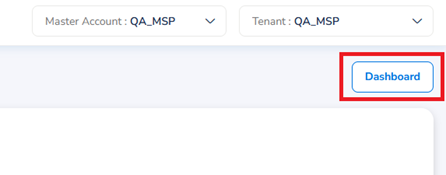Onboarding for OCI Tenancies
Please read first:
Before proceeding with onboarding for this type of cloud account, you must ensure the required pre-onboarding steps have been completed first.
For more information on what these prerequisites are and how to address them, please refer to the Pre-Onboarding for OCI Tenancies user guide.
Introduction
An OCI Tenancy is a user account that provides access to Oracle's cloud services and resources. It enables users to create and manage cloud resources such as compute instances, storage, databases, and networking within Oracle's cloud environment.
The account onboarding process follows a step-by-step flow with four steps, described in the list below. Users must complete every step by filling in the appropriate details so that they can proceed to the next step.
The onboarding flow for OCI cloud accounts covers the following main steps:
- Prerequisites: Select the cloud account scope, access type, and product(s).
- Add & Validate Credentials: Select the authentication type and provide the required OCI account credentials.
- Basic Settings: Select and/or input the basic settings for the cloud account.
- Advanced Settings (optional): This optional step allows users to add tags and set up any required governance configurations. Account governance configurations can also be done after the onboarding steps.
As users add all necessary details for each step in the onboarding flow, it will be marked as completed and no longer appears greyed out in the left sidebar.
Detailed onboarding steps are explained in the sections below.
Note:
Before starting the onboarding process on the platform, make sure that you have followed and completed all the prerequisite steps in the OCI cloud portal. Refer to the PRE-ONBOARDING user guides for more information on how to complete these steps.
Onboarding Steps
Perform the following steps to onboard an OCI Account:
-
Log in to the platform and on the left menu bar, go to Settings > Onboard Accounts.
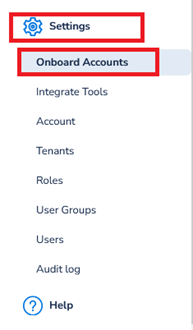
The Onboard Cloud Accounts starting page will appear. Here, users can select which cloud provider to onboard a new account for based on the available options.
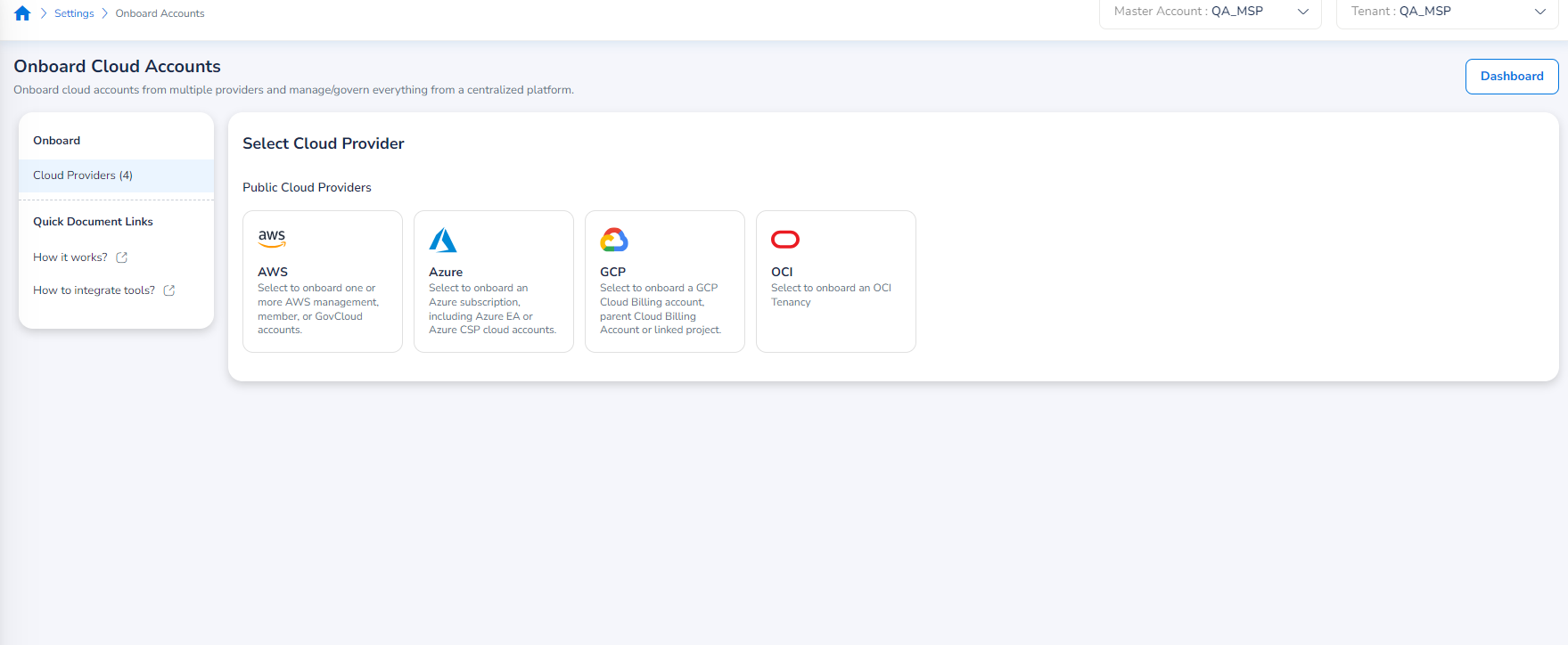
Note:
Users can also use the Dashboard button in the upper right corner of the page to go directly to the Account Governance Dashboard (Cloud Accounts) as a shortcut.
-
To start the onboarding process, hover over the OCI option under Public Cloud Providers, and an Onboard button should appear. Select Onboard to proceed.

-
In the Select Cloud Account Scope field, select one of the following options:
- Tenant: This scope allows the cloud account to be available only in the tenant it is onboarded to. This option is selected by default.
- Account: This scope allows the cloud account to be available in all tenants.
-
In the Select Access Type field, select one of the following options:
-
Read-Only: This option provides viewing access without the ability to make changes.
-
Read-Write: This option allows the users to view, modify, and manage resources.
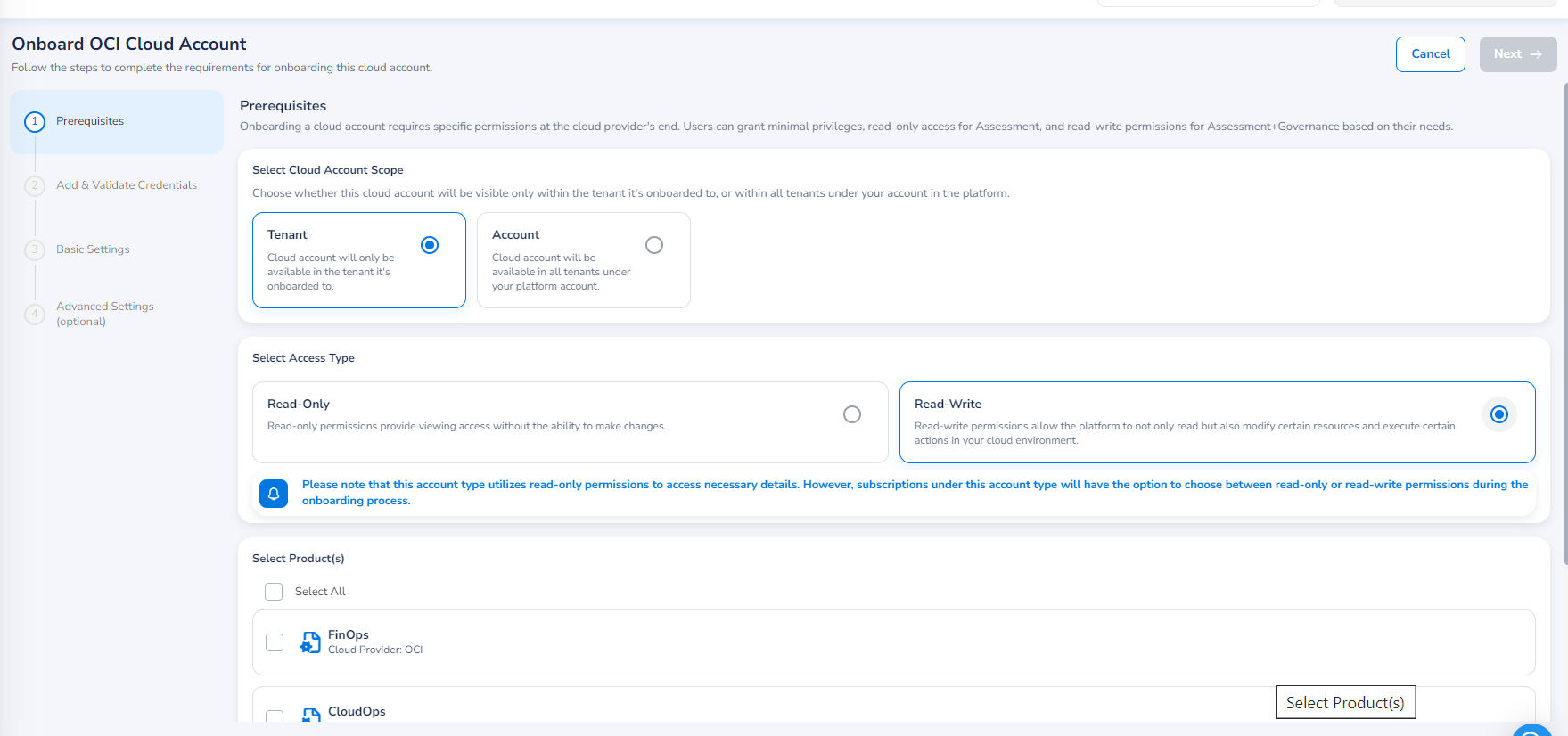
-
-
In the Select Product(s) field, select the products that will be accessible through this account. The available products are shown based on the product bundle that was chosen during the account master creation. For example, the Governance product bundle includes: FinOps, SecOps, and CloudOps.
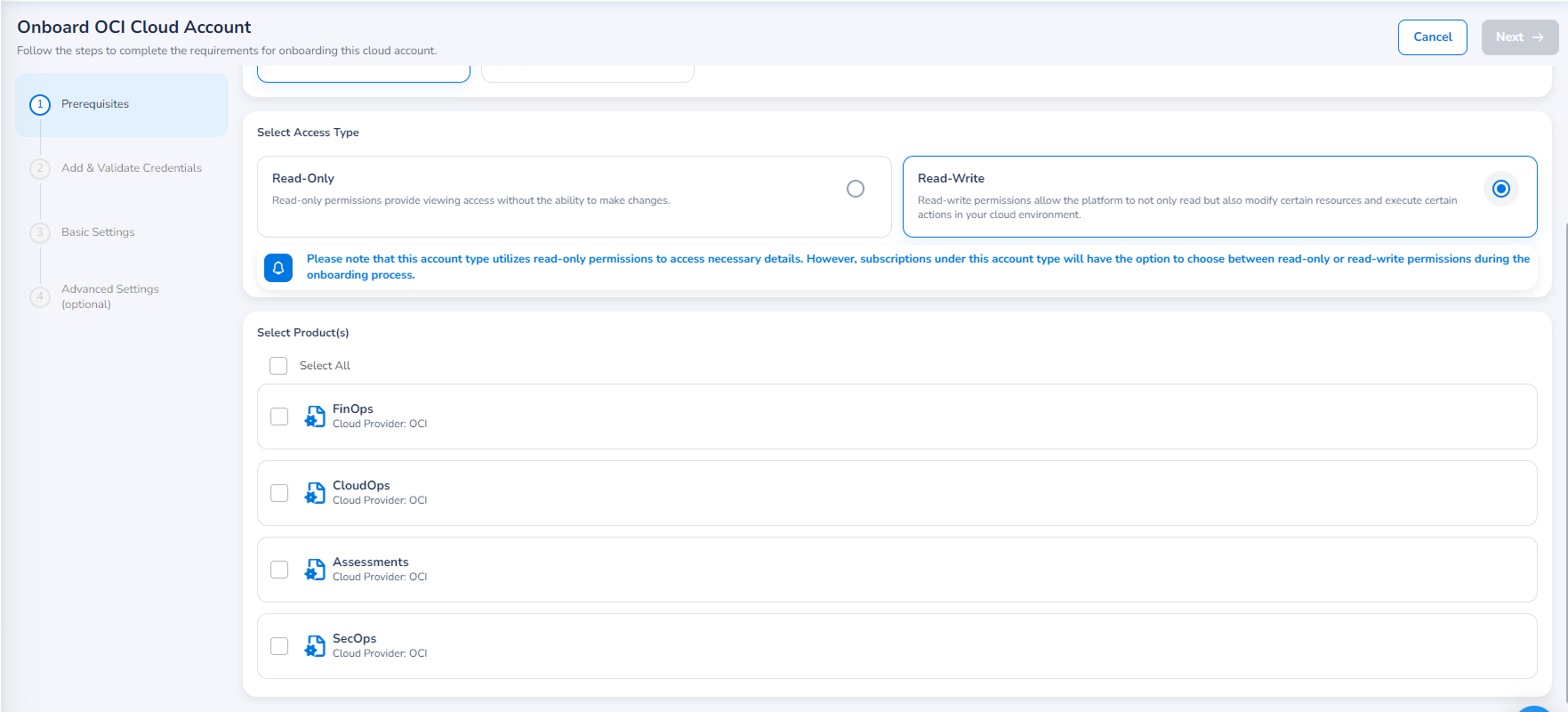
-
Click Next. The Add & Validate Credentials section appears.
-
Fill in the following fields and then click Save & Validate.
-
User ID
-
Fingerprint ID
-
Tenancy ID
-
Default Region
-
In the Upload Credentials File (PEM) field, click Select File, and select the file to be uploaded.
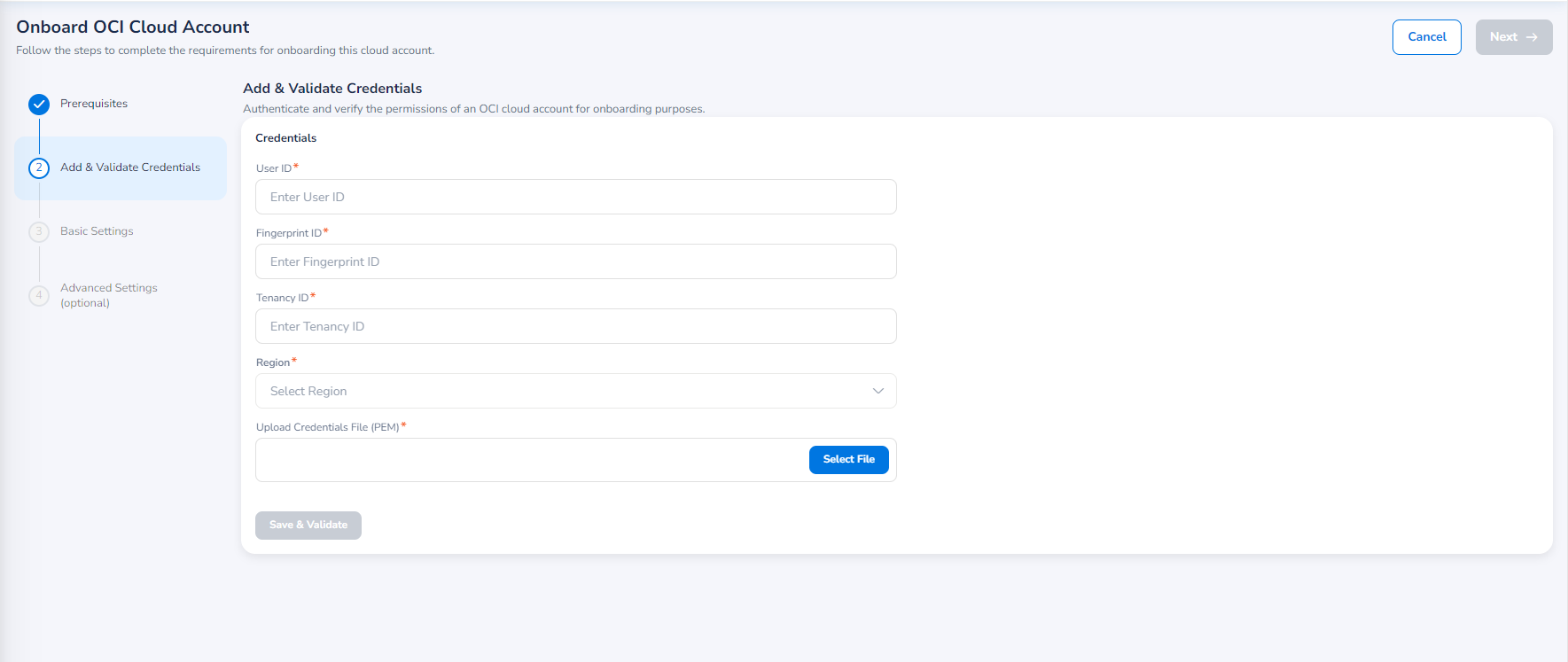
-
If the validation is successful, then a success message will be displayed.
If the validation fails, then an error message will be displayed along with an option for View Log. You can click View Log to view the error details and then click Re-Validate to retry the validation.
Note:
After the completion of successful validation, the Save & Validate button turns to Re-Validate. You can click Re-Validate to validate the account again.
- Click Next. The Basic Settings section appears.
- In the Currency list, click to select a currency in which the billing data will be downloaded from the cloud provider.
Note:
- The Account Name field will be filled by default, but if needed, you can update this field here.
- The Account Name field should not exceed the maximum character limit of 50 characters including special characters.
-
Select the Privacy Policy checkbox to continue with the onboarding process.

-
You can click Next to set up advanced settings or click Finish to complete the account onboarding. Please note that the step for configuring advanced settings is not mandatory and can be skipped.
-
If you click Next, then the Advanced Settings section will be displayed.
- In the Add/Import Cloud Account Tags section, do any of the following to fill in the tag details:
In the Custom Tags field:- In the Key box, type the tag key.
- In the Value box, type the tag value.
- Lastly, click Add Tag. The added tag appears below.
After clicking View Master Account/Tenant Tags: - This opens the Custom Tags dialog box where you can select the required tags and click Add Selected Tags. The selected tags will now show up for the account to be onboarded.
- In the Add/Import Cloud Account Tags section, do any of the following to fill in the tag details:
-
In the Governance Configuration field, click Edit to configure the required settings. Refer to Governance Configuration for detailed steps.

- Click Finish.
The Onboarding Status dialog box appears that shows the progress of account onboarding. You can click Go to the Dashboard to return to the Account Governance Dashboard.
Governance Configuration
The Governance Configuration page includes many sections where configurations can be made. You need to select the configuration you want to apply to your onboarded account. All the available configuration sections are explained below. Refer to the relevant configuration and follow the steps. These governance configurations can be made while onboarding the account or can be done post onboarding.
FinOps
The configurations that can be done for FinOps are explained below.
Cost Anomaly
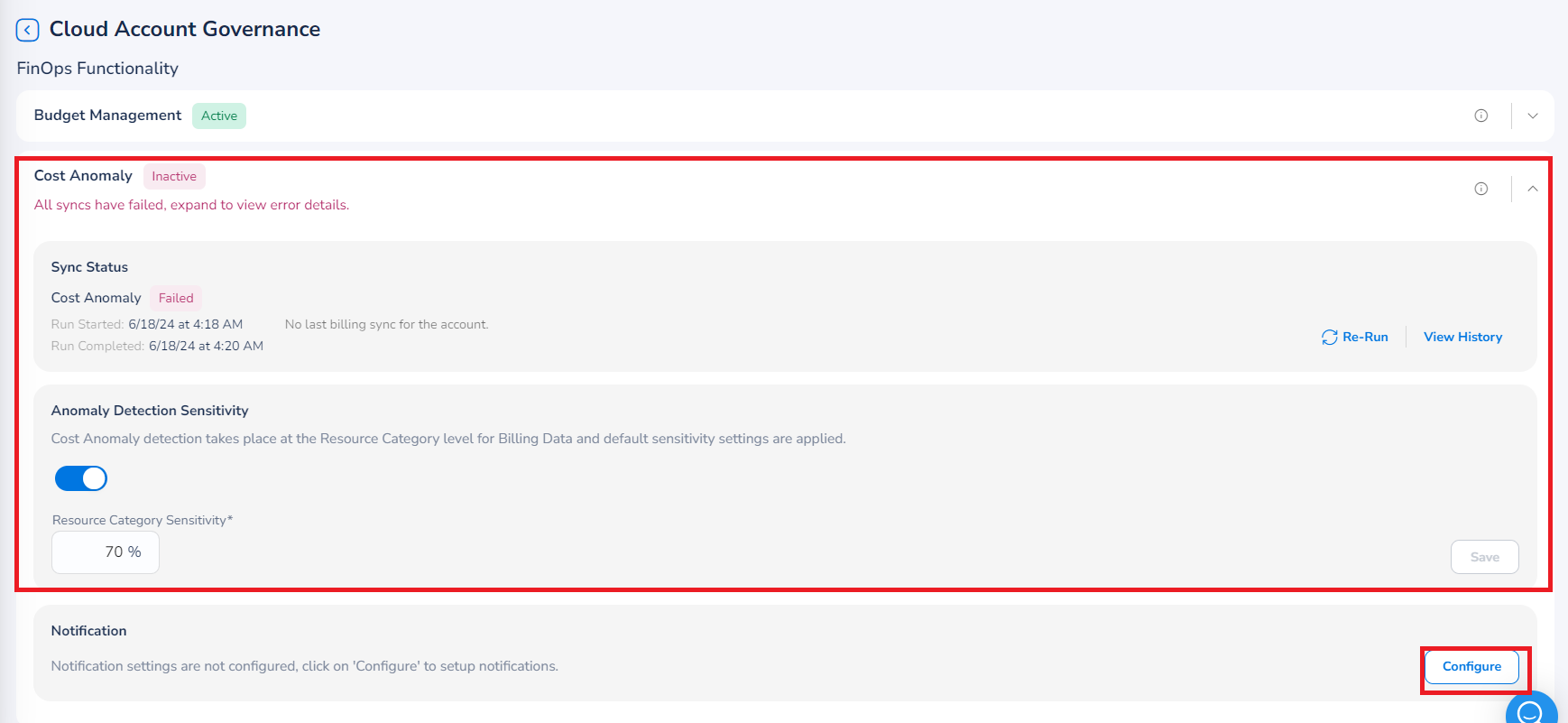
Perform the following steps to configure cost anomaly:
- Expand the Cost Anomaly section.
- Ensure that Anomaly Detection Sensitivity field is enabled (the slider is on the right side).
- In the Resource Category Sensitivity box, the settings are applied by default. If you want to edit the default setting, add the sensitivity based on which anomaly would be detected.
- In the Notification section, click Configure. The Notifications Settings dialog box appears.
a. Select the Enable Notification checkbox. The Email Address, Webhook, and Microsoft Teams Webhook fields are displayed.
b. In the Email Address box, type the email address of the user(s) and click Add.
c. In the Webhook box, type the webhook link(s) and click Add.
d. In the Microsoft Teams Webhook box, type the URL(s) for Microsoft Teams Webhook and click Add.
e. Click Save & Apply.
SecOps
The configurations that can be done for SecOps are explained below.
Threat Management

To make configuration for threat detection, perform the following steps:
- Click to expand the Threat Management section.
- In the Cloud Guard field, move slider towards right to enable this field.
- Click Save.
If configuration is already made for Threat Management, then you can click View to see the existing configuration or you can click Delete to remove the configuration.
To configure notifications related to threat management, perform the following steps:
- In the Notification section, click Configure. The Notifications Settings dialog box appears.
- Select the Enable Notification checkbox. The Email Address, Webhook, and Microsoft Teams Webhook fields are displayed.
- In the Email Address box, type the email address of the user(s) and click Add.
- In the Webhook box, type the webhook link(s) and click Add.
- In the Microsoft Teams Webhook box, type the URL(s) for Microsoft Teams Webhook and click Add.
- Click Save & Apply.
Vulnerability Assessments

To make configuration for vulnerability assessments, perform the following steps:
- Click to expand the Vulnerability Assessments section.
- In the Vulnerability Host Scan field, move slider towards right to enable this field.
- Click Save.
If configuration is already made for Vulnerability Assessments, then you can click View to see the existing configuration or you can click Delete to remove the configuration.
To configure notifications for Vulnerability Assessments, perform the following:
- Click to expand the section, and then click Configure. The Notifications Settings dialog box appears.
- Select the Enable Notification checkbox. The Email Address, Webhook, and Microsoft Teams Webhook fields are displayed.
- In the Email Address box, type the email address of the user(s) and click Add.
- In the Webhook box, type the webhook link(s) and click Add.
- In the Microsoft Teams Webhook box, type the URL(s) for Microsoft Teams Webhook and click Add.
- Click Save & Apply.
CloudOps
The configurations that can be done for CloudOps are explained below.
Activity

To configure activity alerts, perform the following:
- Expand the Activity section.
- In the Activity Log Configuration section, click Configure. A dialog box appears.
- In the Select Regions drop-down list, select one or more relevant option(s) and click Ok.
- Enter an appropriate value for the Service Connector Name.
- Enter an appropriate value for the Topic Name.
- If you want to apply default template for activities to monitor your OCI notifications setup, then select the Apply Default Template checkbox.
- Click Validate.
- Click Save & Exit.
If configuration is already made for activities, then you can click View to see the existing configuration or you can click Delete to remove the configuration.
To configure notifications for activity:
- In the Notification section, click Configure. The Notifications Settings dialog box appears.
- Select the Enable Notification checkbox. The Email Address, Webhook, and Microsoft Teams Webhook fields are displayed.
- In the Email Address box, type the email address of the user(s) and click Add.
- In the Webhook box, type the webhook link(s) and click Add.
- In the Microsoft Teams Webhook box, type the URL(s) for Microsoft Teams Webhook and click Add.
- Click Save & Apply.
Shared Functionality and Integrated Tools
The configurations that can be done for Shared Functionality and Integrated Tools (common across all products) are explained below.
Policy Engine

To configure the policy engine for an account, perform the following steps:
- Expand the Policy Engine section.
- In the Policy Engine list, click to select the policy engine for the account and click Ok.
- Click Save.
Monitoring

To configure monitoring of accounts, perform the following:
- Expand the Monitoring section.
- In the Metric Data Collection Interval field, select the frequency in which the metric data needs to be collected and click Save. The available options are 24 Hours (Daily), 8 Hours Once, and 4 Hours Once.
- Click Save.
To enable alerts:
- In the Alert section, click Configure. A dialog box appears.
- In the Select Regions list, select the relevant option(s) and then click Ok.
- In the Topic Name box, type the name of the topic.
- If you want to apply default template for alerts to monitor your OCI Monitoring setup, then select the Apply Default Template checkbox.
- Click Validate.
- Click Save & Exit.
If configuration is already made for alerts, then you can click View to see the existing configuration or you can click Delete to remove the configuration.
To configure notifications for monitoring alerts, perform the following:
- Click to expand the section, and then click Configure. The Notifications Settings dialog box appears.
- Select the Enable Notification checkbox. The Email Address, Webhook, and Microsoft Teams Webhook fields are displayed.
- In the Email Address box, type the email address of the user(s) and click Add.
- In the Webhook box, type the webhook link(s) and click Add.
- In the Microsoft Teams Webhook box, type the URL(s) for Microsoft Teams Webhook and click Add.
- Click Save & Apply.
Updated 6 months ago
